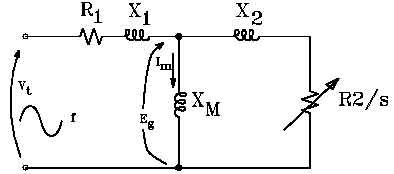AMAZON multi-meters discounts AMAZON oscilloscope discounts
What's the difference between the current measured at the input vs. the output of the inverter (VFD)? Is it lower at the input compared to the output? Are common multimeters able to measure the correct output voltage and current?
The inverter uses a PWM output voltage waveform. Most multimeters will measure the peak voltage and calculate the average from that. In order to measure the voltage, a low-pass filter is required to remove the high-frequency component.
At frequencies below 60Hz, the output voltage from the VFD is below the line voltage. Since VIin = VIout (or Powerin = Powerout, Pin = Pout), the output current must be higher than the input current. That is, at half speed, the output voltage is half, so the output current is double.
Except for the losses in the VFD. at one-half speed, the output current is typically slightly less than twice the input current because the losses are greater in the circuit at that speed (perhaps 5% or even 10%?), but the input current will include those losses.
If one limits the current to 130% of a VFD's rating, how will it behave in case there is a short circuit in outgoing cables or if a motor is grounded? Will the inverter limit the current only up to 130%?
The current limit feature will limit the average current but not the peak current. Most modern drives will shut down if there is an output short circuit. Some of the older drives will burn up.
If the motor 100 HP (75 kW), what is the maximum limit to which the variable-frequency drive can be selected? What will happen if one selects a drive in higher than the motor rating. Will it have affect motor windings and mechanical components?
Usually, there is no problem using an oversized VFD with a motor. If the drive is too large, the drive may not be able to measure the motor-performance current (and other parameters) accurately. In some drives that are closed-loop, sensorless vector, and direct-torque control, there may be an issue (due to measurements) if the drive is too large. The drive manufacturer can help you with this. We don't expect any problems with respect to the motor or the driven load.
Is it true that VFDs keeps a constant voltage/ frequency ratio in order to prevent the core from saturating? If a motor has a full load, can you safely increase the voltage without saturating the core?
Yes: the voltage/frequency ratio must not exceed that of rated voltage and frequency in order to prevent saturation. Even if the motor is fully loaded, you must not exceed this ratio for any period of time. If you refer to the equivalent circuit of the motor (see below), you will see that the magnetizing current (Im, which produces the flux) is a shunt component across the incoming supply and is not really affected by load. It is common, however, to operate the motor at lower flux under reduced-load conditions and that way to lower energy consumption and motor heat.
